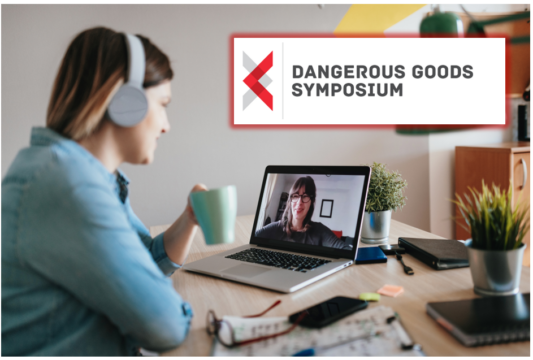
This year’s Dangerous Goods Symposium, for obvious reasons, won’t assemble the world’s leading trainers, shippers and regulators together for three days in the same physical space.
But it will still bring the world’s hazmat shipping community together.
This year, you can experience the Symposium at the new DG Exchange—the Dangerous Goods industry’s first digital community. Instead of traveling to Chicago and crowding into a hotel, you can simply visit the 2020 Symposium/Events tab and register for the sessions that most interest you.
Here’s a quick preview of two sessions you won’t want to miss!
Setting a higher bar for hazmat training

“Compliance vs. Competence—Do You Know What You Don’t Know?”
Jade Eldridge, Advisor EHS – Hazards & Controls, Suncor
Friday, September 11, 10–11 a.m. Central
“There’s a misconception that training equals competence,” says Eldridge. “But in reality, training just opens the door to the first stage of competence. Knowing what you don’t know is better than not knowing.”
Eldridge, who has worked in EH&S at Canadian energy company Suncor for more than five years, adds, “There’s a large gray area between what’s legally required and what can be considered competent. Compliance is the bare minimum, but competence is a higher bar.”
In her DG Symposium session, she’ll discuss what competence at a high level looks like. “What is it, how is it different, and what do workers at this higher level exhibit? Should someone in the same role have the same competencies two, three or four years down the road, or should their competencies expand?”
She’ll also explore different ways of measuring competence and how they may be appropriate for different roles. “For example, if you have people whose main role is applying labels, having them write an exam wouldn’t be a great use of their time. Go watch them for 30 minutes a few times a month. But if you have someone classifying products, it’s a better use of time to test them on a variety of questions.”
Another key question she believes organizations need to ask is, “Is the person assessing competence competent to assess competence? It could be a trainer, a supervisor or a third-party assessor, but in any case it’s important to have a tool—like a rubric with a wide range of responses—that takes out the guesswork.”
Why does competence matter? Why isn’t compliance enough? Eldridge believes companies with a reputation for higher competence have a competitive advantage. “You have to build that reputation, build the competence program, and then your reputation precedes you. It takes a lot of work to get there, and a lot of work to maintain it.”
Sign up for the “Compliance vs. Competence” session now!
Demystifying explosives classifications

Ben Barrett, President, DG Advisor, LLC
Schedule TBD
It’s tempting to say Ben Barrett’s session will be full of explosive developments, but in reality the focus of his work is exactly the opposite. For the last six years, he’s worked with the United Nations GHS Sub-Committee to rewrite Chapter 2.1 of the UN Recommendations on Explosives classification and hazard communication.
“Hazard Class 1.1 is what people think explosives are—a mass explosion hazard,” he says. “HC 1.2 throws deadly metal fragments, and 1.3 is a deadly fire hazard, while 1.4 is no significant hazard—but the exact same chemical can cause all four types of explosion. It’s a function of compartmentalization—how much there is per container and/or device.”
His work with the subcommittee will explain previously unwritten safety principles and extend the system to cover inner packages removed from outer packagings.
“What we’re not going to do is change the transport regulations,” Barrett says. “We’re looking at extending the transport system to properly cover storage. These changes are for the safety of the workers, but they’re of interest to transport professionals who want to understand why explosives are shipped the way they are.”
Barrett expects to be asked questions about the recent devastating explosion in Beirut. “Hazard Class 1.5 was created for ammonium nitrate—it’s a mass explosion hazard, but it’s so insensitive that there’s very little probability of an incident under normal transport conditions. These types of accidents, like the one in Tianjin, China in 2015, are almost always the result of complacency and bad practices.”
His session, he says, will “explain concepts in explosives testing and classification to people who aren’t experts—demystifying the whole process.”
Look for details on the “Explosives” session soon!
Next week: A sneak peek at Lithium Battery Week!
Make sure your shipments are safe and in complete compliance with a full line of solutions from Labelmaster—a full-service provider of goods and services for hazardous materials and Dangerous Goods professionals, shippers, transport operators and EH&S providers.


